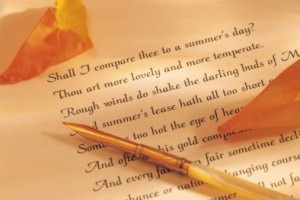Why Is There a Rule Against Poetry Critics Quoting Poetry?

In a recent article, the poetry critic of the New York Times complained that to do poetry criticism right, it’s often necessary to quote extensively from a poem. Indeed, in the case of a short poem, it might be helpful to readers to copy the whole thing. But, the critic said, this can’t be done because it might run afoul of copyright law.
It is true that copyright law prohibits the unauthorized copying of any substantial part of someone’s poem, song, or other work. What does “substantial” mean? Well, in one recent case, a federal court held that rap group N.W.A.’s unauthorized sample of a two-second guitar chord was infringing. The court’s holding was clear: “Get a license, or do not sample.”
Is this a good policy? From an economic perspective, no. Use of a small bit of someone else’s creative work to build a new creative work rarely harms the economic interests of the first copyright owner, because most “derivative” works do not directly compete with the original. In the case mentioned above, no one thought that N.W.A.’s rap song “100 Miles and Runnin’” would lure potential paying customers away from Funkadelic’s “Get Off Your Ass And Jam.” (Note: neither song is safe for work.)
Indeed, N.W.A. was probably more likely to lure new customers to Funkadelic. And if the derivative does not compete with the original, why should copyright law address it? Some argue that copyright owners have a “right” to license their work for use in derivative works, but this is a tautological argument – they have a right only if the law gives them one, and the real question is whether the law should do so in the first place.
For poems, the economic case against “sampling”—i.e., quoting—is even weaker. There’s little fear that copying parts of poems in a New York Times review will destroy the market for the poem – most poems don’t have a market, and indeed pretty much the only ones that do are those for which a market is created by a review in a major outlet like the Times. And yet, for fear of copyright liability, even institutions with the power of the Times have reason to be wary. And a lot of valuable expression is thereby chilled.
Copyright does contain an escape hatch–there is an exception for “fair use.” Unfortunately, fair use is more useful in theory than in fact. Knowing in advance what counts as fair is very difficult, and many publishers—the New York Times included, if the op-ed is to be believed—shy away from anything that a court later might deem unfair. So while an important exception to the general rule against copying, fair use is actually very hard to implement in practice.
In part this is because fair use is a standard, rather than as a set of rules. A standard is a general guide of conduct, for example, “drive carefully.” A rule is a much more specific command, as in “drive 65 miles per hour or less.” Fair use is more like the first than the second – the law sets out some factors that are relevant to whether a use is fair (such as whether the use is commercial or non-commercial, how much of the original work is used, etc.), but these are only guidelines, not rules.
Some countries do it differently. Several European nations structure fair use as a set of narrow and specific exemptions to copyright liability – for example rules allowing limited copying for scientific research, for classroom use, or for non-profit use by libraries and archives.
So what’s better, a set of fair use rules or a single fair use standard? Both have advantages, and there is a large legal literature on when, as a general matter, we ought to have rules or standards. Standards are flexible, and allow courts to consider arguments in instances that would not have been anticipated by rules. But what rules give up in flexibility, they gain in ease of application. They also let people know in advance what is allowed and what is forbidden.
Is there some way we can get the benefit of both rules and standards in how we structure fair use? We think so. We could keep the general standard but start developing rules about particular uses that are fair. For example, given the cultural importance of poetry criticism, and the fact that even reviews that quote heavily are more likely to create a market for a poem rather than destroy one, perhaps we should have a rule declaring bona fide poetry reviews immune from copyright complaints. And perhaps we should have rules about personal and non-commercial uses of copyrighted works – no liability, for example, for using someone’s song as background music for a YouTube video of your toddler dancing. No one’s going to pay for a license to make a use like this, and the video won’t cut into the market for the song.
If we collect enough examples like this, we could develop a robust set of rules that would give people guidance. And the general fair use standard would still be there to handle situations not covered by the rule. None of this suggests that fair use should invade the copyright owner’s core economic interest in profiting from her work. But copyright equally should keep clear of uses that don’t threaten authors’ livelihoods. And to strike that balance better, we need to make some rules.

Comments